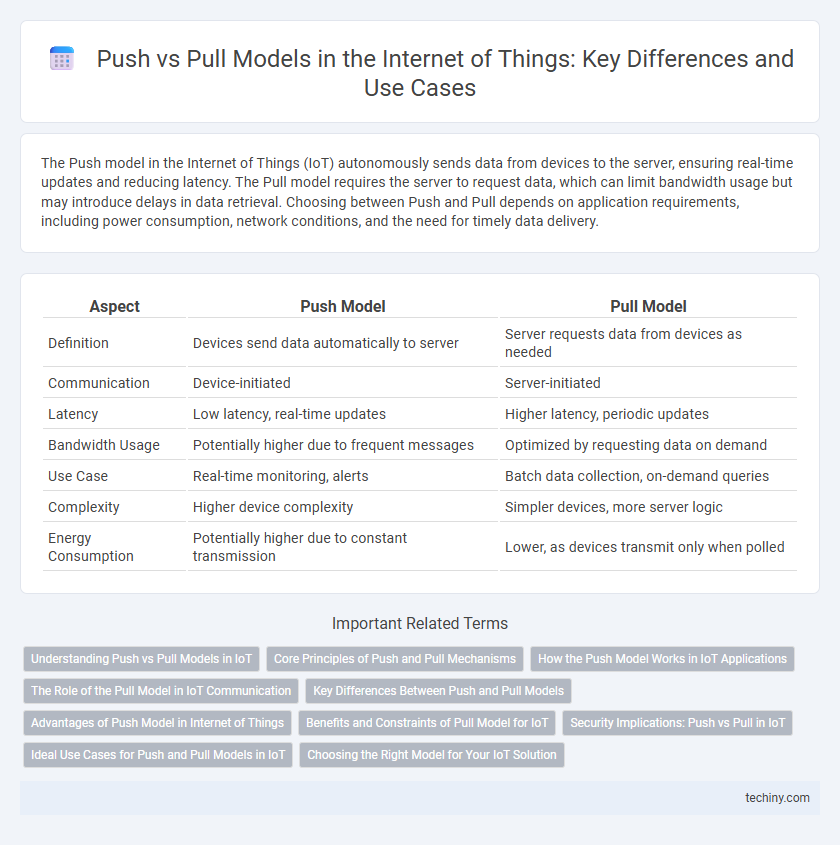The Push model in the Internet of Things (IoT) autonomously sends data from devices to the server, ensuring real-time updates and reducing latency. The Pull model requires the server to request data, which can limit bandwidth usage but may introduce delays in data retrieval. Choosing between Push and Pull depends on application requirements, including power consumption, network conditions, and the need for timely data delivery.
Table of Comparison
| Aspect | Push Model | Pull Model |
|---|---|---|
| Definition | Devices send data automatically to server | Server requests data from devices as needed |
| Communication | Device-initiated | Server-initiated |
| Latency | Low latency, real-time updates | Higher latency, periodic updates |
| Bandwidth Usage | Potentially higher due to frequent messages | Optimized by requesting data on demand |
| Use Case | Real-time monitoring, alerts | Batch data collection, on-demand queries |
| Complexity | Higher device complexity | Simpler devices, more server logic |
| Energy Consumption | Potentially higher due to constant transmission | Lower, as devices transmit only when polled |
Understanding Push vs Pull Models in IoT
Push and pull models in IoT define how data is transmitted between devices and servers, impacting system efficiency and responsiveness. The push model enables devices to send data automatically to the server when specific events occur, reducing latency and enabling real-time monitoring. In contrast, the pull model requires the server to request data from devices periodically, which can conserve bandwidth but may introduce delays in data availability.
Core Principles of Push and Pull Mechanisms
The Push model in the Internet of Things (IoT) involves devices actively sending data to a server or service without waiting for a request, ensuring real-time updates and minimizing latency. In contrast, the Pull model requires clients to request data from devices or servers, which can reduce network traffic by transmitting information only when needed. Core principles of the Push mechanism include event-driven communication and immediate data delivery, while the Pull mechanism emphasizes on-demand data retrieval and efficient resource utilization.
How the Push Model Works in IoT Applications
The Push Model in IoT applications operates by devices or sensors autonomously sending data to a central server or cloud platform without waiting for a request, enabling real-time monitoring and rapid response. This proactive communication reduces latency and minimizes the need for continuous polling, which conserves network resources and improves energy efficiency in connected devices. Push mechanisms are commonly employed in critical applications like smart home automation, industrial monitoring, and health tracking where immediate data transmission is essential for timely decision-making.
The Role of the Pull Model in IoT Communication
The pull model in IoT communication allows devices to request specific data on demand, enhancing efficiency by minimizing unnecessary data transmissions and conserving device energy. This model supports scalability and real-time responsiveness by enabling IoT endpoints to retrieve updates or control commands only when needed. It is particularly effective in scenarios with intermittent connectivity or when data relevance varies dynamically, ensuring optimized bandwidth usage and improved system performance.
Key Differences Between Push and Pull Models
The Push model in the Internet of Things (IoT) proactively sends data from devices to servers or applications, optimizing real-time updates and minimizing latency. The Pull model requires servers or applications to request data from devices on demand, suitable for less time-sensitive information and reducing unnecessary network traffic. Key differences include data transfer initiation, with Push driven by the device and Pull initiated by the receiver, impacting responsiveness, bandwidth usage, and power consumption in IoT deployments.
Advantages of Push Model in Internet of Things
The push model in the Internet of Things (IoT) offers significant advantages by enabling real-time data transmission from devices to servers without requiring constant polling, which reduces latency and conserves bandwidth. It supports efficient resource utilization in constrained environments by minimizing unnecessary network traffic and extending battery life for IoT sensors. Furthermore, push notifications enhance system responsiveness, critical for applications such as smart home automation, industrial monitoring, and healthcare alerts where immediate action is required.
Benefits and Constraints of Pull Model for IoT
The Pull model in IoT enables devices to request data on demand, leading to efficient resource usage by minimizing unnecessary data transmissions. This approach enhances control over data retrieval, reducing network congestion and optimizing battery life for constrained IoT devices. However, the Pull model may introduce latency in data availability and increase complexity in device synchronization for real-time applications.
Security Implications: Push vs Pull in IoT
The Push model in IoT often increases security risks due to unsolicited data transmissions that can expose devices to attacks like spoofing and denial-of-service. In contrast, the Pull model enhances security by allowing devices to request data on demand, reducing the attack surface and improving control over data flow. Secure authentication and encryption mechanisms are critical in both models to protect IoT ecosystems from potential threats.
Ideal Use Cases for Push and Pull Models in IoT
Push model in IoT excels in scenarios demanding real-time alerts and continuous data streaming, such as remote patient monitoring and industrial equipment status updates. Pull model is ideal for applications requiring periodic data retrieval or on-demand querying, like smart meter readings and environmental sensor data collection. Selecting between push and pull depends on latency sensitivity, power consumption, and network bandwidth considerations specific to the IoT deployment.
Choosing the Right Model for Your IoT Solution
Selecting the appropriate communication model for your IoT solution depends on factors such as data latency requirements, network bandwidth, and device power constraints. Push models excel in real-time monitoring scenarios by proactively sending data to servers, reducing latency but potentially increasing energy consumption. Pull models suit applications requiring on-demand data retrieval, optimizing bandwidth and battery life by allowing devices to transmit data only when requested.
Push vs Pull model Infographic

 techiny.com
techiny.com